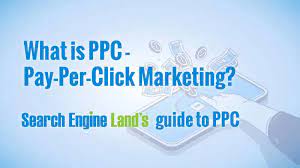Google PPC Online Advertising: A Powerful Tool for Business Growth
In today’s digital landscape, online advertising plays a crucial role in the success of businesses. Among the various online advertising platforms available, Google PPC (Pay-Per-Click) stands out as one of the most effective and widely used methods. With its vast reach, precise targeting options, and measurable results, Google PPC has become an indispensable tool for businesses looking to drive traffic, generate leads, and increase conversions.
What is Google PPC?
Google PPC is an advertising model where advertisers bid on specific keywords relevant to their products or services. When users search for these keywords on Google, the ads appear at the top or bottom of the search engine results page (SERP), marked as “Ad.” Advertisers only pay when someone clicks on their ad, hence the name Pay-Per-Click.
Benefits of Google PPC
Increased Visibility: With billions of searches conducted on Google every day, PPC allows businesses to gain instant visibility and appear prominently in search results. This exposure helps drive targeted traffic to your website and increases brand awareness.
Precise Targeting: One of the key advantages of Google PPC is its ability to target specific audiences based on demographics, location, interests, and even device type. This level of precision ensures that your ads reach the right people at the right time, increasing the likelihood of conversions.
Cost Control: Unlike traditional advertising methods where you pay a flat fee regardless of results, with PPC you have complete control over your budget. You can set daily or monthly spending limits and adjust bids based on performance metrics such as click-through rates (CTR) and conversion rates.
Measurable Results: The beauty of Google PPC lies in its ability to provide detailed performance metrics. You can track impressions, clicks, conversions, cost-per-click (CPC), return on investment (ROI), and more through Google Ads’ robust analytics tools. This data allows you to make informed decisions and optimize your campaigns for maximum effectiveness.
Quick Results: Unlike other forms of digital marketing that require time to build organic traffic or brand recognition, PPC delivers immediate results. Once your campaign is set up and approved, your ads can start appearing on relevant searches within minutes, driving traffic to your website almost instantly.
Tips for Successful Google PPC Campaigns
Keyword Research: Thoroughly research and select relevant keywords that align with your business goals. Use tools like Google’s Keyword Planner to identify high-volume and low-competition keywords.
Compelling Ad Copy: Craft compelling ad copy that grabs attention, highlights unique selling points, and includes a clear call-to-action (CTA). Experiment with different variations to see which resonates best with your target audience.
Landing Page Optimization: Ensure that the landing page users are directed to after clicking on your ad is aligned with the ad’s content and offers a seamless user experience. Optimize it for conversions by including persuasive elements such as testimonials, clear product descriptions, and easy-to-use forms.
Ongoing Monitoring and Optimization: Continuously monitor the performance of your campaigns and make data-driven adjustments as needed. Test different ad variations, tweak bids, refine targeting options, and allocate budget based on what generates the best results.
Seek Professional Assistance: If managing Google PPC campaigns seems overwhelming or time-consuming, consider partnering with a certified Google Ads professional or agency who can provide expertise in optimizing your campaigns for maximum ROI.
In conclusion, Google PPC online advertising offers businesses an incredible opportunity to reach their target audience effectively while maintaining control over their advertising budget. By leveraging its vast reach, precise targeting options, and measurable results, businesses can drive traffic, generate leads, increase conversions, and ultimately achieve their growth objectives in today’s competitive digital landscape.
5 Essential Tips for Successful Google PPC Online Advertising in the UK
- Set realistic goals for your campaigns – decide what you want to achieve and set measurable objectives that can be tracked.
- Ensure you have a clear understanding of the target audience for each campaign – this will help you create more effective ads and choose the right keywords.
- Monitor your campaigns regularly – keep an eye on how they’re performing, adjust bids and budgets as necessary, and optimise for better results.
- Take advantage of Google’s automated bidding strategies – these can help increase ROI while reducing manual effort required to manage campaigns.
- Use negative keywords to ensure your ads are only shown in relevant searches – this will reduce wasted spend and ensure higher quality leads or conversions from your campaigns
Set realistic goals for your campaigns – decide what you want to achieve and set measurable objectives that can be tracked.
Setting Realistic Goals for Your Google PPC Campaigns
When it comes to Google PPC online advertising, setting realistic goals is crucial for achieving success. Before launching your campaigns, take the time to decide what you want to achieve and set measurable objectives that can be tracked. This strategic approach will not only help you stay focused but also provide valuable insights into the effectiveness of your campaigns.
The first step in setting goals is understanding your overall business objectives. Are you looking to increase website traffic, generate leads, boost sales, or enhance brand awareness? Once you have a clear understanding of what you want to achieve, break down these objectives into specific and measurable targets.
For example, if your goal is to increase website traffic, set a target number of visits per month or aim for a certain percentage increase compared to your current traffic levels. If lead generation is your focus, determine how many leads you want to generate within a specific time frame. By setting specific targets, you create a benchmark against which you can measure the success of your campaigns.
It’s important to ensure that your goals are realistic and attainable. While it’s great to aim high, setting unattainable targets can lead to frustration and disappointment. Take into consideration factors such as industry competition, budget limitations, and the current state of your website or landing page.
Once you have set your goals, make sure they are measurable. This means choosing metrics that can be tracked and analyzed within the Google Ads platform. Common metrics include click-through rates (CTR), conversion rates (CVR), cost-per-click (CPC), return on ad spend (ROAS), and overall campaign performance.
Regularly monitor and analyze these metrics throughout your campaign’s duration. This will allow you to assess whether you’re on track towards achieving your goals or if adjustments need to be made. If certain objectives are not being met, consider tweaking different elements such as ad copy, targeting options, or bidding strategies.
Remember, setting realistic goals for your Google PPC campaigns is a fundamental step towards success. It helps you stay focused, provides a clear direction, and allows you to track and measure the effectiveness of your advertising efforts. By continuously evaluating and optimizing your campaigns based on these measurable objectives, you can maximize your return on investment and drive meaningful results for your business.
Ensure you have a clear understanding of the target audience for each campaign – this will help you create more effective ads and choose the right keywords.
To run a successful Google PPC campaign, it is essential to have a clear understanding of your target audience. This knowledge will enable you to create more effective ads and choose the right keywords that resonate with your potential customers.
Identifying your target audience involves delving into their demographics, interests, needs, and preferences. By understanding who your ideal customers are, you can tailor your ad messaging to speak directly to them and address their pain points.
When crafting your ads, consider the language and tone that will resonate most with your target audience. Are they looking for professional advice or a more casual approach? Understanding their preferences will help you create compelling ad copy that grabs their attention and entices them to click.
Additionally, knowing your target audience helps you select the most relevant keywords for your campaign. Conduct thorough keyword research to identify the terms and phrases that align with what your potential customers are searching for. By using these keywords strategically in your ads, you increase the chances of appearing in relevant search results and attracting qualified traffic.
Remember that different campaigns may have different target audiences. Tailor each campaign accordingly by creating separate ad groups or even separate campaigns if necessary. This allows you to fine-tune your messaging and keywords specifically for each segment of your audience, maximizing the effectiveness of your ads.
In summary, understanding the target audience for each Google PPC campaign is crucial for creating more effective ads and choosing the right keywords. By tailoring your messaging to resonate with potential customers and selecting relevant keywords, you increase the likelihood of attracting qualified traffic and achieving better results from your advertising efforts.
Monitor your campaigns regularly – keep an eye on how they’re performing, adjust bids and budgets as necessary, and optimise for better results.
Monitoring Your Google PPC Campaigns: Key to Success
When it comes to running successful Google PPC campaigns, one crucial tip stands out above the rest: regular monitoring. Monitoring your campaigns allows you to keep a close eye on their performance, make necessary adjustments, and optimize them for better results. This proactive approach ensures that your advertising efforts are on track and delivering the desired outcomes.
By monitoring your campaigns regularly, you gain valuable insights into how they are performing. You can track important metrics such as click-through rates (CTR), conversion rates, cost-per-click (CPC), and return on investment (ROI). These metrics provide a clear picture of the effectiveness of your ads and help you identify areas for improvement.
Adjusting bids and budgets is an essential aspect of campaign monitoring. As you gather data and observe trends, you may discover that certain keywords or ad groups are performing exceptionally well while others may not be delivering the desired results. By adjusting bids, you can allocate more budget towards high-performing keywords or decrease bids for underperforming ones. This strategic reallocation helps maximize your budget by focusing it on areas that generate the most value.
Budget optimization is another crucial aspect of monitoring your campaigns. By regularly reviewing your spending patterns and comparing them with the performance metrics, you can ensure that your budget is allocated optimally across different campaigns or ad groups. If a particular campaign is consistently generating positive results, it might be worth considering increasing its budget to capitalize on its success. Conversely, if a campaign is not meeting expectations, adjusting its budget downwards allows for better resource allocation.
Optimization plays a vital role in achieving better results from your Google PPC campaigns. As you monitor their performance, you may discover opportunities to refine various elements such as ad copy, landing pages, targeting options, or even keywords themselves. A/B testing different variations can help identify what resonates best with your target audience and drive higher engagement and conversions.
In conclusion, monitoring your Google PPC campaigns is a fundamental practice for success. By keeping a close eye on their performance, making necessary adjustments to bids and budgets, and optimizing various elements, you can ensure that your advertising efforts are continuously improving. Regular monitoring allows you to adapt to changing market dynamics, stay ahead of the competition, and achieve better results from your Google PPC campaigns.
Take advantage of Google’s automated bidding strategies – these can help increase ROI while reducing manual effort required to manage campaigns.
Maximizing ROI with Google’s Automated Bidding Strategies
When it comes to managing Google PPC campaigns, efficiency is key. One powerful tool that can help businesses increase their return on investment (ROI) while reducing manual effort is Google’s automated bidding strategies. These strategies utilize machine learning algorithms to optimize bids and maximize campaign performance, allowing advertisers to focus on other critical aspects of their business.
Automated bidding strategies offer several benefits that can significantly impact the success of your PPC campaigns. Here’s why you should take advantage of them:
Enhanced Efficiency: Manual bid management can be time-consuming and complex, especially when dealing with large-scale campaigns or multiple ad groups. By utilizing Google’s automated bidding strategies, you can streamline your bid management process and save valuable time and effort.
Optimized Performance: Google’s machine learning algorithms analyze various factors such as historical data, user behavior, and context to determine the optimal bid for each auction. This ensures that your ads are shown to the right audience at the right time, increasing the chances of conversions and maximizing ROI.
Real-Time Adjustments: Automated bidding allows for real-time adjustments based on changing market conditions and user behavior. The algorithms continuously monitor campaign performance and adjust bids accordingly to meet your desired objectives, whether it’s maximizing clicks, conversions, or conversion value.
Advanced Targeting: Automated bidding strategies take advantage of Google’s vast amount of data to identify patterns and trends in user behavior. This enables more precise targeting options, ensuring that your ads are shown to the most relevant audience segments for improved engagement and higher conversion rates.
To make the most out of Google’s automated bidding strategies, here are a few tips:
Choose the Right Strategy: Google offers various automated bidding strategies such as Target CPA (Cost-Per-Acquisition), Target ROAS (Return-On-Ad-Spend), and Maximize Conversions. Carefully assess your campaign goals and select the strategy that aligns best with your objectives.
Monitor Performance: While automated bidding can significantly simplify bid management, it’s crucial to regularly monitor your campaign performance. Keep an eye on key metrics such as conversion rates, cost-per-conversion, and overall ROI to ensure that the automated bidding strategy is delivering the desired results.
Experiment and Optimize: Automated bidding strategies are not set-and-forget solutions. Continuously experiment with different strategies, adjust bids, and fine-tune targeting options to find the optimal combination for your campaigns. Regularly review performance data and make data-driven decisions to optimize your results further.
In summary, by leveraging Google’s automated bidding strategies, businesses can increase their ROI while reducing the manual effort required to manage PPC campaigns. These strategies offer enhanced efficiency, optimized performance, real-time adjustments, and advanced targeting capabilities. By selecting the right strategy and regularly monitoring performance, businesses can unlock the full potential of their PPC campaigns and achieve greater success in their online advertising efforts.
Use negative keywords to ensure your ads are only shown in relevant searches – this will reduce wasted spend and ensure higher quality leads or conversions from your campaigns
Using Negative Keywords in Google PPC Advertising: Maximizing Relevance and Efficiency
When it comes to running successful Google PPC campaigns, one of the essential tips to keep in mind is the strategic use of negative keywords. By incorporating negative keywords into your campaign, you can ensure that your ads are displayed only in relevant searches, reducing wasted spend and attracting higher quality leads or conversions.
What are Negative Keywords?
Negative keywords are specific terms or phrases that you can add to your Google PPC campaign to prevent your ads from showing up in searches that are not relevant to your business. When a search query includes any of these negative keywords, your ad won’t be triggered, saving you from paying for clicks that are unlikely to result in valuable outcomes.
The Benefits of Using Negative Keywords
Increased Relevance: By excluding irrelevant search terms through negative keywords, you can focus your ad impressions on users who are more likely to be interested in what you have to offer. This improves the overall relevance of your ads and helps attract qualified leads who are more likely to convert.
Reduced Wasted Spend: Wasted spend occurs when your ads appear in searches that aren’t relevant to your business. By using negative keywords effectively, you can prevent this unnecessary expenditure and allocate your budget towards more fruitful opportunities.
Improved Click-Through Rates (CTR): When your ads appear only for users actively looking for what you offer, the chances of them clicking through increase significantly. This can lead to higher CTRs, indicating a stronger alignment between user intent and the content of your ads.
Better Conversion Rates: Higher relevancy translates into better conversion rates. By ensuring that your ads are shown exclusively for relevant searches, you increase the likelihood of attracting users who have a genuine interest in your products or services. This ultimately improves the quality of leads or conversions generated from your campaigns.
How to Use Negative Keywords Effectively
Keyword Research: Conduct thorough keyword research to identify potential negative keywords. Think about terms that may be associated with your industry but are not relevant to your specific offerings. For example, if you sell luxury watches, you may want to exclude terms like “cheap watches” or “affordable watches.”
Regular Monitoring and Refinement: Continuously monitor the performance of your campaigns, paying attention to search terms that trigger your ads. Identify any irrelevant or low-performing keywords and add them as negative keywords to prevent future wasteful spending.
Experimentation and Analysis: Test different combinations of negative keywords and analyze the impact on campaign performance. Keep refining your list based on real-time data and adjust as needed to maximize the effectiveness of your targeting.
Utilize Google Ads Tools: Take advantage of Google Ads’ tools such as the Search Terms Report, which provides insights into the actual search queries that triggered your ads. This can help you identify additional negative keywords that you may have missed during initial research.
By incorporating negative keywords into your Google PPC campaigns, you can fine-tune your targeting efforts, reduce wasted spend, and attract higher quality leads or conversions. This strategic approach ensures that your ads are displayed only in searches relevant to your business, maximizing the efficiency and effectiveness of your advertising efforts.




